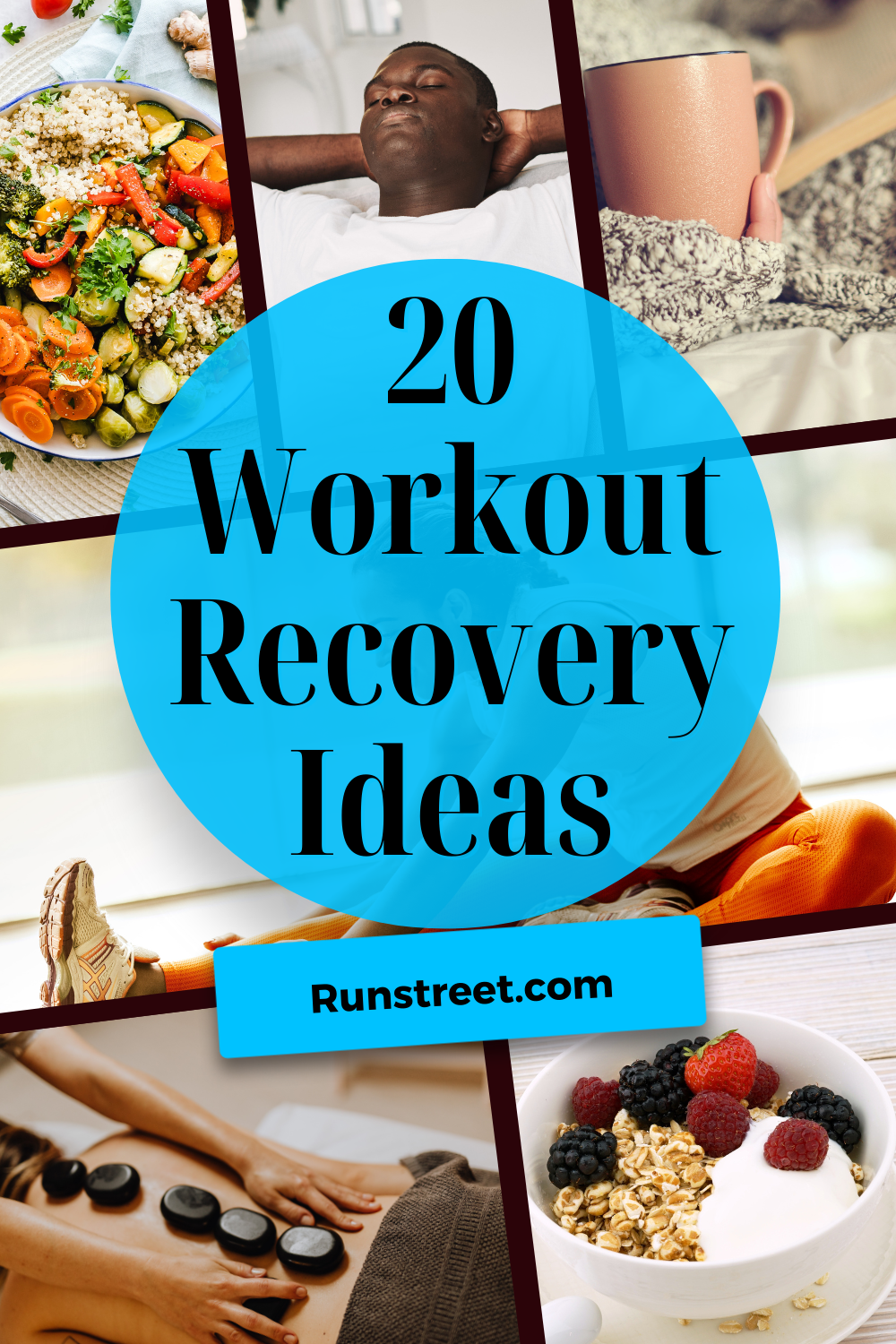20 Tips for Better Workout Recovery
Photo by Marques Jackson Photography.
By Marnie Kunz
Certified trainer and run coach
Improve your workout recovery with these tips. As a trainer and running coach, I often get asked by clients how they can reduce soreness and improve their muscle recovery. Whether you are rehabilitating from a marathon or a tough circuit training session, these suggestions can help speed up your recovery so you can bounce back stronger. These strategies are based on my training experience, a lifetime of running, and scientific research on muscle repair and the recovery process.
What Is Workout Recovery?
Workout recovery is the time it takes for your body to recover from a workout. For light to medium workouts, your body may bounce back in a day or two, whereas high intensity workouts or long workouts (such as a long run) will require more time to recover. Many things can influence how long it takes your tissues to recover from a workout, including your nutrition, sleep habits, age, body condition, the type of workout you did, and lifestyle choices.
The good news is that you can speed up and improve your workout recovery with these tips. Keep in mind that you don’t have to follow every suggestion. Try some of these tips and stick with the ones that work best for you. Also, note that these workout recovery tips are not intended to be a replacement for medical advice. If you have an injury, sharp pain, or persistent pain that does not diminish with time, see a doctor or physical therapist for treatment.
How to Improve Your Workout Recovery
Nutrition
Eating a nutritious diet is one of the best ways you can improve your muscle recovery after a tough workout. The foods you eat can replenish your energy and nourish your muscles if you choose wisely.
1. Eat Protein
Protein is the building block for muscles and energy in the body, so eating enough protein after a hard workout is vital for optimal recovery. Aim to get 20 to 30 grams of protein within 30 minutes of your workout to restore and rebuild your muscles. Sports nutritionists advise consuming about 1.6 grams (g) of protein per kilogram (kg) of body weight per day to maximize muscle growth and recovery.
Some high-protein recovery foods include a protein shake, lentils, protein pasta, tofu, nut butter such as peanut butter or almond butter, eggs, cottage cheese, Greek yogurt, and lean meats such as chicken. Check out our protein smoothie recipes, post-workout snack ideas, and easy meals for post-workout fueling for more suggestions on protein-rich foods to have after exercising.
2. Eat Healthy Carbs
Carbohydrates replenish glycogen in the muscles after hard workouts. Eating enough carbs is important to fuel your workouts and boost your workout recovery. Opt for complex carbs with minimal processing such as brown rice, oatmeal, and quinoa. Try pairing carbs with protein for a post-workout snack or meal. Try oatmeal, bananas, and a side of Greek yogurt, or protein pasta with veggies.
Related Post: What Foods Are Not Processed? Healthy Eating Guide
3. Hydrate
Hydration is an important part of workout recovery and one that’s often overlooked. Most of us drink water when we’re thirsty after a workout, but most people don’t drink enough. Water helps regulate your body temperature, and provides necessary nutrients to muscle tissue, ensuring you can perform at your best when you work out. Water is crucial for muscle recovery, as muscle is made up of 70 percent water. I tell clients to carry around a bottle of water so they’re never without hydration.
Electrolytes are an essential part of hydration, especially for intense workouts like speed training and long runs. When you sweat, your body loses electrolytes, which can lead to muscle cramps, impaired performance and muscle weakness. Put an electrolyte tablet in your water for hot days or intense workouts, or drink a sports drink to replenish your electrolytes.
4. Supplement If Prescribed
Supplements can give you a boost of recovery nutrition if you don’t get enough nutrients in your diet. It’s best to eat a variety of fruits, veggies, whole grains, and lean protein to get most of your nutrients, but if you are lacking in time or healthy food options, you may need a supplement. Talk with your doctor about any nutrients you may be low on based on your annual check-up. Some popular supplements for muscle recovery include protein powder, magnesium, and tart cherry juice. Tart cherry juice helps reduce muscle inflammation while magnesium cuts down on muscle cramps and supports healthy muscle contraction.
Check out my post on supplements for runners for a complete breakdown of supplements and their uses.
Rest and Recover
Rest is an essential part of good workout recovery. Rest includes sleep and taking complete rest days from training.
5. Sleep Enough
Sleep is one of the most important factors that influence your workout recovery time. Aim to get at least 7 to 8 hours of sleep a night or take a nap every day to get a cumulative 8 hours of sleep daily. If you have trouble sleeping, try playing a sleep meditation (available on most meditation apps) and unplug from all your devices two hours before bed.
6. Take Regular Rest Days
Rest days are just as important as hard days in your training program. Take at least one rest day a week to allow your body to recover from training. If you are doing a run streak or training daily, you can make your rest days active recovery days by doing a slow 1-mile jog or going for a walk.
Muscle Rejuvenation
There are some lifestyle factors that you can try to improve your muscle recovery after tough workouts. These range from stretching to massage and foam rolling.
Walking is an excellent form of active recovery.
7. Stretch
Stretching improves the range of motion in your joints and can help reduce your risk of injury. Do some dynamic stretches before a workout - stretches which involve movement, like walking, jumping jacks, lunge walks, etc. After a workout, you can do some static stretches such as toe touches, standing stretches, and seated stretches.
Related Post: Dynamic Stretches for Runners
8. Foam Roll
Foam rolling helps promote blood flow and improves your workout recovery. Foam roll areas where you feel muscle tightness or where you expect to be sore after a tough workout.
9. Get a Massage
Massage helps promote muscle recovery and reduces inflammation from workouts. According to scientists at Harvard and the Wyss Institute, repeated compression from massages helps muscles recover faster and reduces inflammation in the muscles. So treat yourself to a massage or try a massage gun to give your sore muscles a boost of rejuvenation.
10. Try Cryotherapy
Cryotherapy uses freezing or near-freezing temperatures to increase blood flow and promote healing. Many athletes swear by cryotherapy as a means to speed up recovery after tough workouts or events. You can try cryotherapy at a spa or rehabilitative fitness center, but just make sure you do not have any conditions that could put you at risk during cryotherapy, including heart conditions, severe high blood pressure, or pregnancy.
11. Compression
Compression garments are tight-fitting garments that compress the body parts they encase. Compression clothing can help stimulate blood flow and reduce inflammation from workouts. Wearing compression garments can help improve your muscle recovery time and reduce muscle fatigue, inflammation, and pain post-workout. Runners often run in long compression socks, for instance, for long runs, to help reduce wear and tear on the leg muscles.
12. Ice
Ice helps workout recovery in a similar way that cryotherapy does. Icing sore muscles reduce inflammation after tough workouts. I recommend elevating and icing sore muscles for two 10-minute sessions a day until you’re feeling fully recovered.
13. Heat
Heat is another way to reduce inflammation and speed up muscle recovery, reducing delayed onset muscle soreness (DOMS) after hard workouts. Heat improves circulation and allows more nutrients and blood to flow to your recuperating muscles. You can take a warm bath, sit in a sauna or steam room, or apply a heating pad to your sore muscles to accelerate your recovery.
14. Elevate
Elevation can help promote circulation and reduce inflammation. Elevate sore body parts above your heart level to promote recovery. One of my favorite techniques for sore runners is putting their legs up the wall. To do this, you lie down on your back and bend at the waist, putting your legs up the wall for at least 10 minutes. This speeds up muscle recovery after hard leg workouts like long runs.
Related: Complete Guide to Yoga for Runners
Training for Optimal Recovery
Following some basic training principles will boost your workout recovery. I have trained many people who get caught up in the excitement of new fitness or running goals and wind up overworking themselves, delaying their muscle recovery, and oftentimes getting injured. Don’t be that person. Follow these training principles to help you stay healthy in your workout program:
15. Use Progressive Overload in Your Training
Progressive overload is the principle of increasing your duration and intensity gradually to reach higher levels of fitness. When you use this training technique, you will become a better athlete while also reducing your risk of injuries.
16. Follow the Easy-Hard Principle
The easy-hard principle goes along with progressive overload and is especially relevant for running. One of the most common mistakes I see people make with training is to either go hard every day or to go medium every day. It’s important to vary the intensity of your workouts to allow better workout recovery and also to make improvements in your fitness level. The easy-hard principle states that you should follow a hard training day with an easy workout or recovery day. This allows your body to recover more fully from hard training days while maximizing your fitness gains.
17. Practice active recovery
Active recovery helps blood circulate, reduces lactic acid buildup in the muscles, and cuts down on muscle soreness. Active recovery exercises are low-impact such as walking, yoga, or swimming. Active recovery is a proven method of promoting muscle recovery and helps you stay mobile between workouts.
18. Follow the 10 Percent Rule
The 10 percent rule or the principle of progression states that you should only increase your weight amount, duration, or distance of workouts by 10 percent or less each week. This gives your body time to adjust to higher levels of training without getting overworked.
Reducing Stress
Stress can delay workout recovery, so try to de-stress and manage stress in your life as much as possible.
19. Play with Pets
Play with your pet. Some active playtime with your pet will give you active muscle recovery as well as help combat stress. Take a relaxing walk with your dog or play with your cat and you’ll feel the stress melt away.
20. Try Self-Care
Relax with some self-care (see my 51 self-care ideas for inspiration) or de-stress with meditation or deep breathing exercises. Stress will not only impede your muscle recovery but is a common cause of long-term health conditions, so learning to manage stress will help your workout recovery and your quality of life.
Have you tried any of these tactics to speed up your workout recovery? What is your favorite way to recover from tough training days? Comment below and tag @Runstreet on Instagram to get cheered on in your training. Happy sweating to you, and may you recover fully! 😊
Related Posts: When to Take a Rest Day, Marathon Recovery Tips, 3 Best Glute Exercises to Get Results, 51 Self-Care Sunday Ideas to Recharge Body and Mind
Marnie Kunz is a NASM-certified trainer and USATF- and RRCA-certified running coach, dog lover, Akita mom, and writer based in Brooklyn, NY.





